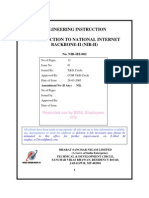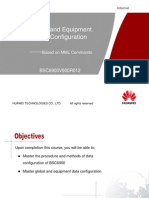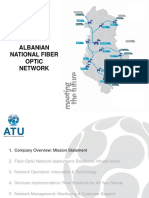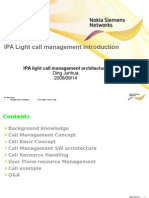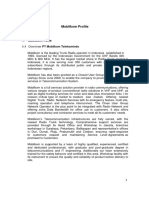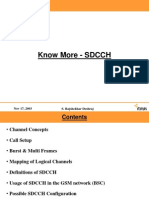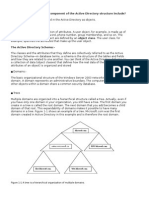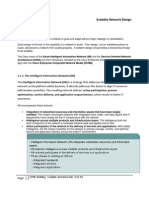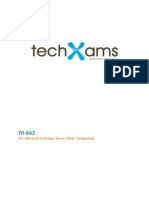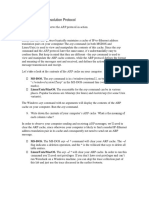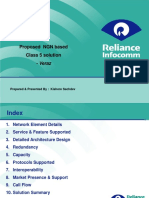HLD Report Ipran Iam v2
HLD Report Ipran Iam v2
Uploaded by
Younes BlxCopyright:
Available Formats
HLD Report Ipran Iam v2
HLD Report Ipran Iam v2
Uploaded by
Younes BlxOriginal Title
Copyright
Available Formats
Share this document
Did you find this document useful?
Is this content inappropriate?
Copyright:
Available Formats
HLD Report Ipran Iam v2
HLD Report Ipran Iam v2
Uploaded by
Younes BlxCopyright:
Available Formats
IPRAN Network High Level Design for Maroc Telecom
Issue Date
1.1 Tuesday,July 15, 2011
IPRAN Network High Level Design for Maroc Telecom
Contents
1 Introduction................................................................................. 4
1.1 Objectives...............................................................................................................................................................4 1.2 Scopes.....................................................................................................................................................................4
2 UMTS Network Structure..............................................................5
2.1 Existing URAN Network........................................................................................................................................5 2.2 Target Network.......................................................................................................................................................5
3 RAN Network Design Requirement................................................7
3.1 Capacity Requirement of Target Network..............................................................................................................7
4 Principles and Information of IPRAN O&M Design...........................9
4.1 O&M Network Topology........................................................................................................................................9 4.2 O&M Networking Principle and Design................................................................................................................9 4.2.1 Existing O&M Network Topology...................................................................................................................9 4.2.2 Target O&M Network Topology....................................................................................................................10 4.2.3 O&M IP Planning Design...............................................................................................................................11 4.2.4 NodeB OM Channel Design...........................................................................................................................13 4.3 NE Time Synchronization Principle and Design..................................................................................................15
5 RAN System Clock Synchronization Design...................................16
5.1 RNC System Clock Source Design .....................................................................................................................16 5.2 NodeB System Clock Source Design...................................................................................................................16
6 IPRAN Resource Distributed Design.............................................18
6.1.1 RNC Transmission Interface Boards Layout Design.....................................................................................18 6.1.2 NodeB Transmission Interface Boards Layout Design..................................................................................19 6.1.3 Boards Distribution Layout............................................................................................................................20
7 RAN Transmission Interface Capability Design..............................22
7.1 Iub Transmission Interface Capability Design.....................................................................................................22 7.1.1 Traffic Mapping on IP Strategy Design..........................................................................................................22 7.1.2 Total Iub User Plane Throughput for Iub IP Transmission Estimation...........................................................24 7.2 Iub Transmission Configuration Design for Typical NodeB................................................................................26
8 IPRAN Transmission Interface Reliability Design...........................27
8.1 Iub Transmission Interface Networking Reliability Design.................................................................................27
IPRAN Network High Level Design for Maroc Telecom
8.1.1 Iub Networking Topology...............................................................................................................................27 8.1.2 Iub Interface Boards Redundancy Design......................................................................................................28 8.1.3 Iub Transmission Ports Redundancy in RNC Design.....................................................................................28 8.1.4 Iub Transmission Fault Detection Design......................................................................................................28 8.1.5 Iub Transmission QoS Difference Design......................................................................................................28 8.1.6 Iub Transmission Layer Address Allocation Design......................................................................................30
9 Acronyms and Abbreviations.......................................................32
IPRAN Network High Level Design for Maroc Telecom
1
1.1 Objectives
Introduction
Based on the customer requirement to migrate the ATM IUB interface to IPRAN network, high level design (HLD) is to reasonably design the UMTS RAN networking to establish an IP UTRAN network. The UTRAN network has the following features: Using IP as the bearer on IUB interface for all 3G services Being of good security, high reliability, and reasonable resource allocation Supporting features extension
HLD focuses on Huawei RAN network elements (NEs) ,mainly NodeB and RNCs.
1.2 Scopes
This document involves HLD for the Maroc Telecom IPRAN. According to the features of the Huawei UMTS product, HLD covers IPRAN networking migration, focusing on operation and maintenance (O&M), system clock synchronization, IPRAN resource distributed design, transmission interface capability, transmission interface networking reliability, interconnection negotiation, and common features.
IPRAN Network High Level Design for Maroc Telecom
2
2.1 Existing URAN Network
UMTS Network Structure
Iub interface on existing UTRAN network is based on ATM over SDH networks, 19 RNCs and 1600 NodeB communicate each other through the TDM network,the RNC clock synchronizationis provided by IUCS interface, NodeBs use line clock extracted from IUB E1 links. M2000 maintain RNCs by direct connection based on PPP over E1,all NodeB communicate with M2000 through RNCs, in other word the OM link of NodeB is carried over IUB.
Fig: Existing UTRAN Network Architecture
2.2 Target Network
In the targeted IPRAN network, Maroc Telecom requires to migrate from ATM to IP all de services carried on IUB interface. The TDM E1s are maintained only for Clock synchronization in the first phase ,later on, SyncE and/or PTP synchronization will replace E1 . IUCS,IUPS,IUR interfaces will not be changed.
IPRAN Network High Level Design for Maroc Telecom
Fig: Target UTRAN Network Architecture
IPRAN Network High Level Design for Maroc Telecom
3
1.1.1.1 Target Network Scale
Distribution of NodeBs On 11/05/2011
RAN Network
Design Requirement
3.1 Capacity Requirement of Target Network
The entire target Maroc Telecom will include 19 RNCs and around 1600 NodeBs which are distributed as below
NE Name RNC_TangerMsallah RNC-AinSbaa RNC-CasaAnwal RNC-CasaGare RNC-CasaNU RNC-CasaOualfa RNC-CasaSidiOtmane RNC-FesAdarissa RNC-FesNarjis RNC-HayNahda RNCJedida RNC-Kenitra RNC-Meknes RNC-RabatCentre RNC-Settat RNC-TangerIbnTaymia RNC-TangerPrincipal RNC-Tetouan RNC-TetouanMyHassan Total
Total NodeB 97 136 149 106 148 26 30 44 74 129 94 80 163 1 63 1 114 83 67 1605
1.1.1.2 Interface Connection Requirement
Each RNC connect to IPRAN through 2 Different access points (CEX)
IPRAN Network High Level Design for Maroc Telecom
The NodeBs connect to IPRAN using one GE optical port All Connections are 1 GE optical fibers
Fig: RNC and NodeB interconnection with the IPRAN
1.1.1.3
Product Version Information
Version Information RNC Node B BSC6810 V200R011, BSC6900 V200R011 BTS3900 V200R011, BTS3812 V200R011
1.1.1.4 Requirements for Transmission QoS
Requirements for Iub transmission QoS:
Time delay ms IUB Max 40 suggest 10 Delay variation ms Max 15 suggested 2 Packet lost Max 1.00E-03 suggested 1.00E-04
IPRAN Network High Level Design for Maroc Telecom
4
4.1 O&M Network Topology
Principles and
Information of IPRAN O&M Design
M2000 manage and maintain NodeB directly through IP network without passing by RNC.
Fig: Topology of Target O&M network
4.2 O&M Networking Principle and Design
4.2.1 Existing O&M Network Topology
The RNC BAMs are connected to the local router using FE ,each RNC uses a.b.c.d/29 subnet. The RNC router is then connecter to Central OMC router in Sokarno using E1.Static routes are defined in RNC ,M2000 and on Both Local and central routers. The NodeB communicate with M2000 through RNCs, which define internal routes between Iub interface and M2000.
IPRAN Network High Level Design for Maroc Telecom
Fig: Topology of Existing O&M network Existing OM Network IP design: Used IP Remarks 2.X.Y.Z/8 3.X.Y.Z/8 . PPP between RNC router and M2000 router . . 20.X.Y.Z/8 172.121.139.0/24 172.121.138.0/24 RNC BAM Segment 192.168.8.0/24 M2000 Segment
4.2.2 Target O&M Network Topology
In order to enable the M2000 to access NodeB directly through IPRAN, The M2000 will connect to IP:MPLS backbone, The OM channel reliability and security can be enhanced by connecting both active and standby OSS system to IP backbone.
10
IPRAN Network High Level Design for Maroc Telecom
Fig: NodeBs OM/IPRAN configuration Hay nahda and Sokarno M2000 local routers configure VRRP to assure geographical redundancy. The M2000 LAN segment will not be changed 192.168.8.0/24 Here below the actual addressing for M2000 servers and routers:
M2000 IP address Router IP address
Sokarno Hay Nahda
192.168.8.22/24 192.168.8.24/24
192.168.8.88/24 192.168.8.89/24
4.2.3 O&M IP Planning Design
The RNC OM Link will not be changed, The NodeB is maintained by the M2000 or the maintenance terminal (including LMT) through the remote OM channel. The recommended remote NodeB maintenance channel is over the IP link. IP data streams are terminated on the Iub interface board. Through IP routing, O&M packages are routed to the main control board of the NodeB for processing.
11
IPRAN Network High Level Design for Maroc Telecom
Fig: NodeB ETHIP & OMIP
the OM IP addresses are numbered in ascending order on the same network segment according to NodeB numbers. For each RNC ,NodeB group are /24 network segment, maximum reserved IP per RNC is 254 ,the proposed planning is as below:
RNC Name RNC-CasaGare RNC-AinSbaa RNC-CasaAnwal RNC-CasaNU RNC-CasaOualfa RNC-CasaSidiOtmane RNC-FesAdarissa RNC-FesNarjis RNC-Meknes RNC-Kenitra RNCHayNahda RNC-RabatCentre RNCJedida RNC-Settat RNC-TangerIbnTaymia RNC-TangerPrincipal RNC-Tetouan RNC-TetouanMyHassan RNC_TangerMsallah
Target Node B 250 250 250 250 250 250 250 250 250 250 250 250 250 250 250 250 250 250 250
OM NodeB 10.146.0.0/24 10.146.1.0/24 10.146.2.0/24 10.146.3.0/24 10.146.4.0/24 10.146.5.0/24 10.146.8.0/24 10.146.9.0/24 10.146.10.0/24 10.146.12.0/24 10.146.13.0/24 10.146.14.0/24 10.146.16.0/24 10.146.17.0/24 10.146.20.0/24 10.146.21.0/24 10.146.22.0/24 10.146.23.0/24 10.146.24.0/24
NodeB OM IP planning
12
IPRAN Network High Level Design for Maroc Telecom
4.2.4 NodeB OM Channel Design
1.1.1.5 OMCH Policy
It is recommended that the NodeB is directly routed to the M2000 for maintenance without passing the RNC. This can separate service channels from maintenance channels, thus enhancing network security. The OM packet are carried over the same VLAN 200,OM and other services on IPRAN are differentiated using QoS priority .
1.1.1.6 DSCP Design
The Differentiated Service is a method of providing different services with different transmission priorities. All the IUB services are carried over a single VLAN, the priority policy are assured by layer 3 and layer 2 tagging:
Signal Plane
User Plane
OAM
3GPP Traffic Type Common Channel,SRB AMR Voice Visio R99 Streaming R99 Interactive R99 Background SHSPA Streaming HSPA Interactive, HSPA Background O&M
PHB (Per Hop Behavior) CS6 EF EF AF41 AF31 AF31 AF41 AF21 AF41
DSCP 48 46 46 34 26 26 34 18 34
IEEE802.1 Ppriority 6 5 5 4 3 3 4 2 4
The recommended OM DSCP is 34, at IEEE802.1p level the OM is tagged with priority 4,
1.1.1.7 OMCH Configuration
Route 1: On the NodeB side, configure a route to the M2000. The next hop is the interface IP address of the access Router to IPRAN. Route 2: On the M2000, configure a route to the NodeB OMIP. The next hop is the interface IP address of the PE Router. In addition, the routes of transmission equipment need to be configured. OSPF is configured between OSS router and IP backbone
13
IPRAN Network High Level Design for Maroc Telecom
Figure 1.1 Configuring an OMCH
(1) Router A and B , Two PE use OSPF VPN, A---PE haynahda use sub interface to connect ,also Router B---PE sokarno (2) switch E and F interface use the trunk to permit the VLAN pass. (3) Router A -----M2000 haynahda do not use sub interface also M2000 sokarno------Router B. (4) Router A and B configure VRRP in the interface which connected Switch C and D. the heard packets path like A--C---D---B.
14
IPRAN Network High Level Design for Maroc Telecom
OSS Node M2000 Huawei Rabat Sokarno M2000 Huawei Rabat Hay Nahda
IP
192.168.111.1/30 192.168.111.5/30
PE Node PE_NE80E_RABAT_SOEKARNO_03 PE_NE80E_RABAT_HAY_NAHDA_02
IP
192.168.111.2/30 192.168.111.6 /30
Tab: Proposal of IP Planning for M2000 interconnection with MPLS backbone
4.3 NE Time Synchronization Principle and Design
The RNC keep the same configuration of the time synchronization, it recover Time data from SNTP server set in M2000. The NodeB can be set to the SNTP client only. The NodeB time synchronization server recommended by Huawei is the M2000: NodeB time synchronization parameters:
Time Synchronization Parameter Time synchronization server Address of the time clock synchronization server Time synchronization period
Recommended Value M2000 IP address of the M2000 server 6 hours
Number of the port used by the time synchronization 123 server
Fig: Logical line of NodeB time synchronization
15
IPRAN Network High Level Design for Maroc Telecom
RAN System Clock
Synchronization Design
This chapter describes the system clock source design of the RNC and NodeB and flow directions of relevant system clocks.
5.1 RNC System Clock Source Design
The RNC clock synchronization is provided by the STM1 link connecting the MGW to RNC.the RNC synchronization mode will not be changed after migration to IPRAN.
Fig: System clock stream of the RNC
5.2 NodeB System Clock Source Design
Tow scenarios are supported by NodeB for clock synchronization:
16
IPRAN Network High Level Design for Maroc Telecom
The Iub interface uses currently the TDM transport: all NodeB are connected to RNC using E1, Therefore, it is recommended to set the NodeB to extract clock signals from the existing E1, or from any other transmission equipment able to provide 2Mhz input for the NodeB. The NodeB supports also the IP clock synchronization, in this scenario; both SyncE and 1588v2 are supported by the BTS
1.1.1.8 E1 Clock Synchronization
Fig: E1 Clock synchronization
Keep TDM transmission for NodeB synchronization (Synchronization Over E1) Smooth migration to IP
1.1.1.9 IP Clock Synchronization
17
IPRAN Network High Level Design for Maroc Telecom
Fig: IP Clock synchronization
All service are based on metro IP network, no need for the E1 network for the clock The NodeB extract The clock using GE interface, the clock can be SyncE or 1588v2 Clock source based on IP should be provided by IPRAN network
IPRAN Resource
Distributed Design
This chapter describes optimization design for RNC capabilities, involving board configuration, the port controller, NodeB allocation.
6.1.1 RNC Transmission Interface Boards Layout Design
The GOUa interface is the main GE interface of RNC,it s recommended to use 2 GOUa Board in load share mode to connect each RNC to IPRAN. The GOUa board performs the following functions:
Provides two channels over GE optical ports, which are used for IP transmission Provides the Automatic Protection Switching (APS) function between the active and standby boards Provides the routing-based backup and load sharing
18
IPRAN Network High Level Design for Maroc Telecom
Fig: Panel of the GOUa board
6.1.2 NodeB Transmission Interface Boards Layout Design
BTS 3900 will be provided with UTRP board, each UTRP board can be added in slot 4 or 5 in the BBU base band module. The UTRP support 2 GE optical ports.
Fig: Panel of the UTRP (with 2 GE port)
For BTS3812 / DBS a hardware upgrade is mandatory to support GE optical, for those sites an extra module will be provided to allow GE inter connection with IPRAN
19
IPRAN Network High Level Design for Maroc Telecom
6.1.3 Boards Distribution Layout
The figure below shows an example of GOUa board configuration of the RNC according to the preceding design rules for board configuration.
Fig:Board configuration for the RNC
The design of GE ports per RNC is detailed in the following table
RNC RNC_TangerMsallah RNC-AinSbaa RNC-CasaAnwal RNC-CasaGare RNC-CasaNU RNC-CasaOualfa RNC-FesAdarissa RNC-FesNarjis Sub 2 Slot 24 TX0 Sub 2 Slot 24 TX0 Sub 2 Slot 24 TX0 Sub 2 Slot 24 TX0 Sub 2 Slot 24 TX0 Sub 0 Slot 18 TX0 Sub 0 Slot 24 TX0 Sub 2 Slot 24 TX0
1st GE Sub 2 Slot 24 RX0 Sub 2 Slot 24 RX0 Sub 2 Slot 24 RX0 Sub 2 Slot 24 RX0 Sub 2 Slot 24 RX0 Sub 0 Slot 18 RX0 Sub 0 Slot 24 RX0 Sub 2 Slot 24 RX0 Sub 2 Slot 25 TX0 Sub 2 Slot 25 TX0 Sub 2 Slot 25 TX0 Sub 2 Slot 25 TX0 Sub 2 Slot 25 TX0 Sub 0 Slot 19 TX0 Sub 0 Slot 25 TX0 Sub 2 Slot 25 TX0
2nd GE Sub 2 Slot 25 RX0 Sub 2 Slot 25 RX0 Sub 2 Slot 25 RX0 Sub 2 Slot 25 RX0 Sub 2 Slot 25 RX0 Sub 0 Slot 19 RX0 Sub 0 Slot 25 RX0 Sub 2 Slot 25 RX0
20
IPRAN Network High Level Design for Maroc Telecom
RNC-HayNahda RNC-Jedida RNC-Kenitra RNC-Meknes RNC-Settat RNC-SidiOtmane RNC-TangerPrincipal RNC-Tetouan RNC-TetouanMyHassan RNC-RabatCentre RNC-TangerIbnTaymia
Sub 1 slot 18 TX0 Sub 2 Slot 24 TX0 Sub 1 slot 26 TX0 Sub 1 slot 22 TX0 Sub 2 Slot 24 TX0 Sub 1 slot 20 TX0 Sub 1 slot 18 TX0 Sub 0 slot 16 TX0 Sub 0 slot 26 TX0 Sub 1 slot 20 TX0 Sub 0 slot 18 TX0
Sub 1 slot 18 RX0 Sub 2 Slot 24 RX0 Sub 1 slot 26 RX0 Sub 1 slot 22 RX0 Sub 2 Slot 24 RX0 Sub 1 slot 20 RX0 Sub 1 slot 18 RX0 Sub 0 slot 16 RX0 Sub 0 slot 26 RX0 Sub 1 slot 20 RX0 Sub 0 slot 18 RX0
Sub 1 slot 19 TX0 Sub 2 Slot 25 TX0 Sub 1 slot 27 TX0 Sub 1 slot 23 TX0 Sub 2 Slot 25 TX0 Sub 1 slot 21 TX0 Sub 1 slot 19 TX0 Sub 0 slot 17 TX0 Sub 0 slot 27 TX0 Sub 1 slot 21 TX0 Sub 0 slot 19 TX0
Sub 1 slot 19 RX0 Sub 2 Slot 25 RX0 Sub 1 slot 27 RX0 Sub 1 slot 23 RX0 Sub 2 Slot 25 RX0 Sub 1 slot 21 RX0 Sub 1 slot 19 RX0 Sub 0 slot 17 RX0 Sub 0 slot 27 RX0 Sub 1 slot 21 RX0 Sub 0 slot 19 RX0
RNC Ports allocation design From NodeB side ,the UTRP board is configured in slot 4 or 5 as described here below:
Fig: usage of the UTRP interface boards in BTS/DBS 3900.
21
IPRAN Network High Level Design for Maroc Telecom
RAN Transmission Interface Capability Design
This chapter provides recommended transmission configurations on the control plane and user plane of each IUB over IP interface .
7.1 Iub Transmission Interface Capability Design
This section describes how different services on IUB are mapped over IP transmission resources.
7.1.1 Traffic Mapping on IP Strategy Design
IP transport networking of the Iub interface indicates that the protocol (IP) stack networking is used between the RNC and the NodeB.
22
IPRAN Network High Level Design for Maroc Telecom
With the development of data services, especially the introduction of the HSDPA/HSUPA, the Iub interface has larger and larger requirements for transmission bandwidth. Introducing the IP transmission technology can save the cost.
1.1.1.10 IP transport Networking
IP transport can transmit the services of different QoS in different ways. Real time services have higher priority than HSPA services. the figure here below shows the IP transport networking.
Fig: IP transport networking
The Maroc Telecom RNC is configured with the IP interface board (GOUa). The IP interface board is connected to the IP transmission network through the GE port. The NodeB is connected to the IP transmission networks through the corresponding IP interface boards.
1.1.1.11 Design for the Transmission Resource Mapping Table
The transmission resource mapping table (TRMMAP) shown in following table is designed according to Maroc Telecoms requirement and the transmission resource allocation.
Service Type Common channel IMS SRB SRB AMR voice R99 CS conversational R99 CS streaming R99 PS conversational R99 PS streaming R99 PS high PRI interactive R99 PS middle PRI interactive R99 PS low PRI interactive
IAM Request EF EF EF EF AF41 AF41 AF41 AF41 AF31 AF31 AF31
23
IPRAN Network High Level Design for Maroc Telecom
R99 PS background HSDPA Signal HSDPA IMS Signal HSDPA Voice HSDPA conversational HSDPA streaming HSDPA high PRI interactive HSDPA middle PRI interactive HSDPA low PRI interactive HSDPA background HSUPA Signal HSUPA IMS Signal HSUPA Voice HSUPA conversational HSUPA streaming HSUPA high PRI interactive HSUPA middle PRI interactive HSUPA low PRI interactive HSUPA background
AF31 EF EF AF41 AF41 AF41 AF21 AF21 AF21 AF21 EF EF AF41 AF41 AF41 AF21 AF21 AF21 AF21
TRMMAP of the Iub interface in IP transport
7.1.2 Total Iub User Plane Throughput for Iub IP Transmission Estimation
1.1.1.12 Existing IUB Throughput
Based on the current IUCS, IUPS throughput per RNC and the number of NodeB attached to each RNC , an average of IUB throughput is calculated :
24
IPRAN Network High Level Design for Maroc Telecom
Total Iub Thruput Kbps 350000 300000 250000 200000 150000 100000 50000 0
12 :3 0 15 :3 0 18 :3 0 21 :3 0 0: 30 3: 30 6: 30 9: 30 12 :3 0 15 :3 0 18 :3 0 21 :3 0 0: 30 3: 30 6: 30 9: 30 12 :3 0
The trend above shows the throutput of RNC Ainsebaa ( Iub interface including 144 NodeB),the peak required bandwidth for Iub is 300 Mbps, then the average of used Iub bandwidth per NodeB is 2 Mbps ,
1.1.1.13 Target IUB Throughput
Taking in consideration the expansion of the network and the introduction of new enhanced features, requirements in term of bandwidth are increased, therefore a model design of Iub is performed in order to respond to the future bandwidth demand. We admit the following assumption:
25
IPRAN Network High Level Design for Maroc Telecom
1) 2) 3) 4) 5)
NodeB and RNC are both RAN11 HSPA+ 21 Mbps is activated (increase the traffic around 16% ) Current bandwith is the the Physical Iub Bandwidth (7 Mbps) S222 is implemented in all hard ware (double the current traffic) No limitation in term of Hardware processing
Current Max bandwidhth :7 Mbps S222 Max Bandwidth ( x2): 14 Mbps Hspa+ (+ 16%) = 16.24 Mbps PS: the Model above is a theatrical one based on some assumption, an accurate model should take in account the Number of user per RNC and traffic model.
7.2 Iub Transmission Configuration Design for Typical NodeB
It s recommended to use 4 IPPATH in user plan to differentiate each service priority, for control plan NCP and CCP are assigned DSCP 48. The Qos is assured according to layer 2 and layer 3 mapping (DSCP,VLAN priority)
Tx(kbps) Signal Plane NCP CCP EF AF41 AF31 AF21 AF41 Rx(kbps) DSCP Vlan Priority
User Plane OAM
Physical Link BW Physical Link BW Physical Link BW Physical Link BW
Physical Link BW Physical Link BW Physical Link BW Physical Link BW
48 48 46 34 26 18 34
6 6 5 4 3 2 4
26
IPRAN Network High Level Design for Maroc Telecom
IPRAN
Transmission Interface Reliability Design
This chapter describes the reliability design of transmission interfaces, including the network topology of the Iub, redundancy of interface boards and ports, failure detection, QoS, transmission security design, and address allocation. This can ensure reliable and secure transmission, detect failures in time, and differentiate priorities to guarantee high-priority services.
8.1 Iub Transmission Interface Networking Reliability Design
8.1.1 Iub Networking Topology
Fig: Iub networking
The Iub interface uses the IP transmission and supports IP protocol stacks. Active and standby GOUa boards provide GE port to connect two CEX Routers ,the GOUa corresponding ports are configured in load share. Therefore The RNC provide 2 interface IP and one logical IP for communication. In NodeB side, one GE port is used to support connection. The load sharing is assured by configuring 2 routes for each NodeB with different priority (high & low),
27
IPRAN Network High Level Design for Maroc Telecom
One of them pass through the active GOU the second one pass through standby one. the NodeBs are balanced in both GOU, in other Word 50% of NodeB High priority Routes is over active GOU, and the rest NodeB high priority routes are over standby GOU.
8.1.2 Iub Interface Boards Redundancy Design
1.1.1.14 Board Redundancy Principle
In the case of board backup, one board is active and the other is standby. When the active board is faulty, switchover occurs and the standby board serves as active board. The processing capability of one pair of active and standby boards is equivalent to the processing capability of one active board. Board backup can improve network reliability. Services can run normally so long as one of the active and standby boards works properly. In the case of non-redundancy, the failure of a board may interrupt network services.
1.1.1.15 Recommended Board Redundancy Mode
It is recommended that GOUa work in boards backup mode for the Iub interface.
8.1.3 Iub Transmission Ports Redundancy in RNC Design
GOUa Port Redundancy Principle
When a pair of GOUa boards work in the backup mode, the corresponding ports of the active and standby GOUa boards can be also in the backup mode, for example, port 0 of active board and port 0 of standby board. Board backup and port backup are independent,Thus GE ports can be both active while the related board are in active standby mode.
Recommended port Redundancy Mode
It is recommended that the 2 port are work in active in order to assure load sharing over Iub interface.
8.1.4 Iub Transmission Fault Detection Design
BFD detection can be used to detect gateway of RNC GE port connectivity according to RNC license.
8.1.5 Iub Transmission QoS Difference Design
In terms of wireless network layers, the transmission network layers of the RNC and NodeB first map service priorities into the DiffServ PHB at the IP layer, mark the service priorities with different DSCPs, and then map the service priorities into the VLAN priority domain through the PHB. In addition, operators can flexibly configure the mapping between subscriber service priorities and IP QoS and the mapping between IP QoS and VLAN priorities according to the requirement. Therefore, the QoS-related design covers the following three parts:
Transmission Resource mapping table for Iub, that is, the mapping between services and transmission resources (paths). It may use the default map for Iub IP. DSCP values design for the user plane IPPATH, signaling plane SCTPLNK, and the OM in IP transmission.
28
IPRAN Network High Level Design for Maroc Telecom
Mapping between the DSCP and the VLAN priority in IP transmission.
1.1.1.16 QoS Requirements for IP over Ethernet Transmission
All the service are mapped on one VLAN. The DSCP and VLAN priority design agreed with the customer engineering and planning department is summarized in the table below:
PHB (Per Hop Behavior) CS6 CS6 EF EF AF41 AF31 AF31 AF41 AF21 AF41
3GPP Traffic Type Common Channel,SRB Synchronisation (IEEE 1588) AMR Voice Visio R99 Streaming R99 Interactive R99 Background SHSPA Streaming HSPA Interactive,HSPA Background O&M
DSCP 48 48 46 46 34 26 26 34 18 34
IEEE802.1 Ppriority 6 6 5 5 4 3 3 4 2 4
QoS Requirements for IP over ATM Transmission
For few NodeB (around 10) the IUB transmission is expected to be based on IP over ATM, using PTN equipment, The related QOS design is as follow: ATM service type NCP Signal Plane CCP ALCAP AMR voice R99 CS/PS conversational/streaming HSPA voice/conversational/streaming AMR voice R99 CS/PS conversational/streaming User Plane HSPA voice/conversational/streaming AMR voice R99 CS/PS conversational/streaming HSPA voice/conversational/streaming R99 PS interactive/background HSPA interactive/background IPOA ATM Service class PVC CBR 1/40 CBR 1/41 CBR 1/42 RT-VBR 1/50 PW PW1 IP QOS CS6
RT-VBR
1/51
PW2
EF
RT-VBR NRT-VBR UBR UBR+
1/52 1/53 1/54 1/33
PW3
AF21
OAM
29
IPRAN Network High Level Design for Maroc Telecom
8.1.6 Iub Transmission Layer Address Allocation Design
RNC IP Address Planning
In IP L3 (FE/GE) networking, it is recommended to use Ethernet IP address for each FE/GE port to connect to the transmission equipment, another device IP should be defined as logical IP for communication with NodeB.
1.1.1.17
RNC Fig: IP requirements of RNC
IPRAN
IP1_IP2/IP3_IP4 are used for interconnection with CEX Device IP5_IP6 are logical IP used for communication with NodeB (Service and OM) IP1/IP3/IP5 can not be in the same subnet The segment 1 and 2 are provided according to IPRAN planning design The segment 3 is designed by UTRAN, in addition, another 3 segment per RNC are reserved by UTRAN for future migration to dynamic routing.
RNC Name RNC-CasaGare RNC-AinSbaa RNC-CasaAnwal RNC-CasaNU RNC-CasaOualfa RNC-CasaSidiOtmane RNC-FesAdarissa RNC-FesNarjis RNC-Meknes RNC-Kenitra RNCHayNahda RNC-RabatCentre RNCJedida RNC-Settat RNC-TangerIbnTaymia RNC-TangerPrincipal RNC-Tetouan RNC-TetouanMyHassan RNC_TangerMsallah Target Node B 250 250 250 250 250 250 250 250 250 250 250 250 250 250 250 250 250 250 250 OM & Service RNC & NE40 192.168.1.0/28 192.168.1.16/28 192.168.1.32/28 192.168.1.48/28 192.168.1.64/28 192.168.1.80/28 192.168.1.96/28 192.168.1.112/28 192.168.1.128/28 192.168.1.144/28 192.168.1.160/28 192.168.1.176/28 192.168.1.192/28 192.168.1.208/28 192.168.1.224/28 192.168.1.240/28 192.168.2.0/28 192.168.2.16/28 192.168.2.32/28
30
IPRAN Network High Level Design for Maroc Telecom
Fig:RNC IP Planning proposal for OM/services and NE40(dynamic routing)
1.1.1.18 NodeB Address Planning
In IP L3 (FE/GE) networking, the address of a NodeB (ETHIP) must not be on the same network segment as the RNC interface boards ETHIP and DEVIP. Each NodeB needs one ETHIP and one OMIP.
NodeB Fig: IP requirements of NodeB
IPRAN
IP1_IP2 is used for interconnection and traffic/signaling, the planning is provided by IPRAN IP3 is used for O&M Network 10.22.1.X is reserved and can not be used The IP planning proposal for NodeB OM is described in : 4.2.3 O&M IP Planning Design
31
IPRAN Network High Level Design for Maroc Telecom
9
AAL2 ALCAP AMR ARP ATM BAM BITS BPS CCP CN CRNC CS DHCP DRNS DSCP EMS ESN FE FP GE GPS GTP-U HDB3 HSDPA HS-DSCH HSUPA IP IPDV IPLR IPTD IUUP LMT M2000 MAC MBMS MDC MGW MSC MSP MTP3 MTU NBAP NCP NodeB NRI ATM Adaptation Layer type 2 Access Link Control Application Part Adaptive Multi Rate Address Resolution Protocol Asynchronous Transfer Mode Back Administration Module Building Integrated Timing Supply System Board Protect Switch Communication Control Port Core Network Controlling RNC Circuit Switched Dynamic Host Configuration Protocol Drift RNS DiffServ Code Point Element Management System Electronic Serial Number Fast Ethernet Frame Protocol Gigabit Ethernet Global positioning system GPRS Tunneling Protocol User Plane High Density Bipolar 3 High Speed Downlink Packet Access High Speed Downlink Shared Channel High Speed Uplink Packet Access Internet Protocol IP Packet Delay Variation IP Packet Loss Rate IP Packet Time Delay Iu Interface User Plane Local Maintenance Terminal iManager M2000 Medium Access Control Multimedia Broadcast Multicast Service Macro Diversity Convergence Media Gateway Mobile services Switching Canter Multiplex Section Protection Message Transfer Part Level 3 Maximum Transfer Unit NodeB Application Protocol NodeB Control Port WCDMA base station Network Resource Identifier
Acronyms and Abbreviations
32
IPRAN Network High Level Design for Maroc Telecom
NRNC NRT OMC OMIP PDCP PPP PPS PS PVC QoS RAN RANAP RBS RLC RNC RSS RTP RT-VBR SAAL SCTP SDH SGSN SHO SNTP SRNC STM-1 UBR UDP UE UMTS UNI UTRAN VCI VLAN VPI VRRP
Neighboring Radio Network Controller Non-Real-Time Operation and Maintenance Center IP Address of Operation and Maintenance Packet Data Convergence Protocol Point-to-Point Protocol Port Protect Switch Packet Switched Permanent Virtual Channel Quality of Service Radio access network Radio Access Network Application Part RNC Business Subrack Radio Link Control Radio Network Controller RNC Switch Subrack Real-Time Transport Protocol Real Time Variable Bit Rate Signaling ATM Adaptation Layer Stream Control Transmission Protocol Synchronous Digital Hierarchy Serving GPRS Support Node Soft HandOver Simple Network Time Protocol Serving RNC SDH Transport Module-1 Unspecified Bit Rate User Datagram Protocol User Equipment Universal Mobile Telecommunications System User-Network Interface UMTS Terrestrial Radio Access Network Virtual Channel Identifier Virtual Local Area Network Virtual Path Identifier Virtual Route Redundancy Protocol
33
You might also like
- F5 LTM Lab Manual-1 PDFDocument82 pagesF5 LTM Lab Manual-1 PDFHendra SoenderskovNo ratings yet
- Backbone Microwave Technical Proposal V1.1Document23 pagesBackbone Microwave Technical Proposal V1.1Salman LabiadhNo ratings yet
- Company Profile - WeNetworkllcDocument38 pagesCompany Profile - WeNetworkllc71177335No ratings yet
- EtgrDocument63 pagesEtgrToni MartinNo ratings yet
- E3-E4 - Text - Chapter 4. BROADBAND, MULTIPLAY AND MNG PANDocument14 pagesE3-E4 - Text - Chapter 4. BROADBAND, MULTIPLAY AND MNG PANkishansingh35No ratings yet
- National Internet Backbone IIDocument13 pagesNational Internet Backbone IIAbhinav100% (10)
- IPRAN Deployment Guide V210-20090303Document132 pagesIPRAN Deployment Guide V210-20090303UsersNo ratings yet
- 03 - LTE Dimensioning Guidelines - Indoor Link Budget - FDD - Ed1.1 - InternalDocument52 pages03 - LTE Dimensioning Guidelines - Indoor Link Budget - FDD - Ed1.1 - InternalDreamer_ShopnoNo ratings yet
- TCI - TX HLD - Phase1 PDFDocument29 pagesTCI - TX HLD - Phase1 PDFjamos200No ratings yet
- 4G Lte PDFDocument29 pages4G Lte PDFgjfjgjmgmjNo ratings yet
- TRANSMISSION TX REPORTDocument8 pagesTRANSMISSION TX REPORTChristopher AiyapiNo ratings yet
- 01 OptiX RTN 900 V100R002 Product Description 20100223 ADocument54 pages01 OptiX RTN 900 V100R002 Product Description 20100223 AJoseLuis AvilaNo ratings yet
- Hspa RNPDocument20 pagesHspa RNPامين بوعزيزNo ratings yet
- Telecoms ResumeDocument8 pagesTelecoms ResumeSahilKhan100% (1)
- Thapar University PatialaDocument38 pagesThapar University PatialajajaNo ratings yet
- BSC6900V900R012 UO Global and Equipment Data Configuration-20101218-B-V1.0Document50 pagesBSC6900V900R012 UO Global and Equipment Data Configuration-20101218-B-V1.0AlfredoNo ratings yet
- Oel CCN PDFDocument9 pagesOel CCN PDFAbdul ShakoorNo ratings yet
- Synopsis: Submitted By: Mandeep Singh C09529 Eece 4 SEMDocument10 pagesSynopsis: Submitted By: Mandeep Singh C09529 Eece 4 SEMOmji PandeyNo ratings yet
- ATU PresentationDocument13 pagesATU PresentationJenn AlavaNo ratings yet
- Hamid - 6 - TXN - BSS CVDocument5 pagesHamid - 6 - TXN - BSS CVHamid MasoodNo ratings yet
- Scurity in LTE NetworksDocument27 pagesScurity in LTE NetworksyassminbgNo ratings yet
- Imteyaz - PDF 2Document9 pagesImteyaz - PDF 2IMTEYAZ mallickNo ratings yet
- 023 TrainingDocument37 pages023 TrainingLaserNo ratings yet
- IL1 Call Management IntroductionDocument89 pagesIL1 Call Management IntroductionLotfiBouhalloufaNo ratings yet
- HW 076765Document40 pagesHW 076765sulissetiawatiNo ratings yet
- Mobilkom Profile 1.1Document11 pagesMobilkom Profile 1.1dian santosoNo ratings yet
- WDM TheTransmodeWay ADocument96 pagesWDM TheTransmodeWay Acarlzhang75No ratings yet
- CCNA Discovery 4 Final ExamDocument22 pagesCCNA Discovery 4 Final ExamAbraham Gebreyohanes100% (1)
- MQTT and LoRaDocument8 pagesMQTT and LoRanabin.bhusalNo ratings yet
- Monthly Report 2Document22 pagesMonthly Report 2khalid hussenNo ratings yet
- Polarfire Fpga Cpri An4949Document39 pagesPolarfire Fpga Cpri An4949ANSHUL SONINo ratings yet
- Samit Jana: Experience in Wide Deployment of Mixed Wired/Wireless/Fiber Network in Kathmandu ValleyDocument37 pagesSamit Jana: Experience in Wide Deployment of Mixed Wired/Wireless/Fiber Network in Kathmandu ValleySamit JanaNo ratings yet
- CANoe Ethernet ProductInformation v1.0Document6 pagesCANoe Ethernet ProductInformation v1.0Chaos XiaNo ratings yet
- National Telecommunication Corporation (NTC)Document40 pagesNational Telecommunication Corporation (NTC)Faheem Sajid100% (1)
- NID4083 - 1.4.1 Designing An IP-Transport Network For DTTDocument25 pagesNID4083 - 1.4.1 Designing An IP-Transport Network For DTTtrucaitNo ratings yet
- Paper 03Document6 pagesPaper 03sanskargade03No ratings yet
- Chapter 2.3GConceptDocument16 pagesChapter 2.3GConceptmanojkumartomar7513No ratings yet
- 5G New Use CaseDocument3 pages5G New Use CaseChitwan BhardwajNo ratings yet
- 3G BTS Systems and NEC Electronics (1/2) : Mobile Phone System StructureDocument7 pages3G BTS Systems and NEC Electronics (1/2) : Mobile Phone System StructureAnkit BajpaiNo ratings yet
- Prima Comm Guide Line (Ignore CCTV)Document30 pagesPrima Comm Guide Line (Ignore CCTV)Teo Yan TeeNo ratings yet
- ReportDocument37 pagesReportSharmeen AnannaNo ratings yet
- E5-E6 TelecomDocument125 pagesE5-E6 TelecomKalai SelvanNo ratings yet
- Evolution of UTRAN ArchitectureDocument5 pagesEvolution of UTRAN ArchitectureAhmad FrazNo ratings yet
- Use Cases of 5GDocument17 pagesUse Cases of 5GDinoNo ratings yet
- End-To-End 4G Solutions: For Mobile Bwa Wimax & LteDocument4 pagesEnd-To-End 4G Solutions: For Mobile Bwa Wimax & LteIsrael KoffmanNo ratings yet
- 2 AT4 Wireless IoT Seminar LTE Rev4Document43 pages2 AT4 Wireless IoT Seminar LTE Rev4Hernan SernaNo ratings yet
- Implementation of Iot System For Securing Telecommunications Infrastructure Based On Lorawan Operator'S NetworkDocument6 pagesImplementation of Iot System For Securing Telecommunications Infrastructure Based On Lorawan Operator'S NetworkHợpですNo ratings yet
- LTE System Signaling Procedures Huawei eNODEbDocument60 pagesLTE System Signaling Procedures Huawei eNODEbgopizizouNo ratings yet
- Cisco MWR 2941-DC Mobile Wireless Router: Product OverviewDocument7 pagesCisco MWR 2941-DC Mobile Wireless Router: Product Overviewmansour14No ratings yet
- 5G Explained: Security and Deployment of Advanced Mobile CommunicationsFrom Everand5G Explained: Security and Deployment of Advanced Mobile CommunicationsNo ratings yet
- Reconfigurable Radio Systems: Network Architectures and StandardsFrom EverandReconfigurable Radio Systems: Network Architectures and StandardsNo ratings yet
- LTE Self-Organising Networks (SON): Network Management Automation for Operational EfficiencyFrom EverandLTE Self-Organising Networks (SON): Network Management Automation for Operational EfficiencySeppo HämäläinenNo ratings yet
- Hantom or Dummy RACH: Contribute To Scribd To Access This DocumentDocument1 pageHantom or Dummy RACH: Contribute To Scribd To Access This DocumentYounes BlxNo ratings yet
- Accmin Ericsson c1Document1 pageAccmin Ericsson c1Younes BlxNo ratings yet
- Tic Tac Toe Game Best One Ever Howtoandtohow?Document1 pageTic Tac Toe Game Best One Ever Howtoandtohow?Younes BlxNo ratings yet
- Know More - SDCCH: Nov 17, 2003 S. Rajshekhar DeshrajDocument53 pagesKnow More - SDCCH: Nov 17, 2003 S. Rajshekhar DeshrajYounes BlxNo ratings yet
- 1.3.5 HSPA+ RRM PolicyDocument1 page1.3.5 HSPA+ RRM PolicyYounes BlxNo ratings yet
- DC Stop: Design and ConstructionDocument1 pageDC Stop: Design and ConstructionYounes BlxNo ratings yet
- Mobile Radio Measurements 30: Digital Radiocommunication Testers CMD54, CMD57, CMD59Document6 pagesMobile Radio Measurements 30: Digital Radiocommunication Testers CMD54, CMD57, CMD59Younes BlxNo ratings yet
- Training Material For CDMA Mobile Communication SystemDocument910 pagesTraining Material For CDMA Mobile Communication SystemYounes BlxNo ratings yet
- DT Basics Modified 27 MayDocument8 pagesDT Basics Modified 27 MayYounes BlxNo ratings yet
- Handover: Network Optimization SSMC Training CenterDocument88 pagesHandover: Network Optimization SSMC Training Centerumairhaider10667% (3)
- Huawei RNP User Manual v1.0Document324 pagesHuawei RNP User Manual v1.0b0r3l_01No ratings yet
- Ihlp Report PDFDocument12 pagesIhlp Report PDFDipika GhoshNo ratings yet
- Started On State Completed On Time Taken Marks GradeDocument3 pagesStarted On State Completed On Time Taken Marks GradeBhavesh PariharNo ratings yet
- FTB8510UMDocument333 pagesFTB8510UMmdsartaj7428No ratings yet
- AWS Certified Advanced Networking Specialty - Exam GuideDocument14 pagesAWS Certified Advanced Networking Specialty - Exam GuideAdnan AshrafNo ratings yet
- Q1. What Does The Logical Component of The Active Directory Structure Include?Document9 pagesQ1. What Does The Logical Component of The Active Directory Structure Include?javedcgNo ratings yet
- LTE-Ready Wireless Backhaul: Tzvika Naveh, Director of Network SolutionsDocument24 pagesLTE-Ready Wireless Backhaul: Tzvika Naveh, Director of Network SolutionsGATTHHHNo ratings yet
- CSE Computer NetworksDocument14 pagesCSE Computer NetworksSree MahaNo ratings yet
- Mobile Ad-Hoc Network Management in The Cloud: Hazzaa Naif Alshareef Dan GrigorasDocument8 pagesMobile Ad-Hoc Network Management in The Cloud: Hazzaa Naif Alshareef Dan GrigorassathyatnNo ratings yet
- Packet Network Topology PDFDocument8 pagesPacket Network Topology PDFVidyashree TumkurkarNo ratings yet
- Lecture23 - IP AddressDocument26 pagesLecture23 - IP AddressFiroz kumarNo ratings yet
- Windows TCPIP Registry SettingsDocument8 pagesWindows TCPIP Registry Settingskktamang09No ratings yet
- Gxw42xx User Manual EnglishDocument64 pagesGxw42xx User Manual EnglishDinesh RamjuttunNo ratings yet
- Module1 - Scalable Network DesignDocument26 pagesModule1 - Scalable Network DesignGerryNo ratings yet
- CJAB BK D6497E98 00 Deployment-Installation-guide-ciscojabberDocument14 pagesCJAB BK D6497E98 00 Deployment-Installation-guide-ciscojabberSid Ali Oulad SmaneNo ratings yet
- TD LTE Test CasesDocument6 pagesTD LTE Test CasesDavid VargasNo ratings yet
- CIS 6395, Incident Response Technologies Fall 2016, Dr. Cliff ZouDocument45 pagesCIS 6395, Incident Response Technologies Fall 2016, Dr. Cliff ZoumariaNo ratings yet
- TS: Microsoft Exchange Server 2010, ConfiguringDocument8 pagesTS: Microsoft Exchange Server 2010, ConfiguringNiraj DubeyNo ratings yet
- IPBrick Manual - Referencia - ENV5.2Document280 pagesIPBrick Manual - Referencia - ENV5.2Mahmoud AhmedNo ratings yet
- Using Samba On Debian LinuxDocument4 pagesUsing Samba On Debian LinuxMárcio O BorgesNo ratings yet
- The Address Resolution Protocol: ARP CachingDocument4 pagesThe Address Resolution Protocol: ARP CachingHarshit JaiswalNo ratings yet
- OTB105101 OptiX Metro 3100 System Hardware ISSUE2.10Document98 pagesOTB105101 OptiX Metro 3100 System Hardware ISSUE2.10r_mahbubNo ratings yet
- Lab3 Wireshark Ethernet ARP v6.01Document8 pagesLab3 Wireshark Ethernet ARP v6.01Alina NedelciuNo ratings yet
- Using Device Manager To Configure The SEL-2488 Clock: Application Guide AG2021-28Document16 pagesUsing Device Manager To Configure The SEL-2488 Clock: Application Guide AG2021-28RafaelNo ratings yet
- Catalyst 3750 Switch Software Configuration Guide: Cisco IOS Release 12.1 (14) EA1 July 2003Document942 pagesCatalyst 3750 Switch Software Configuration Guide: Cisco IOS Release 12.1 (14) EA1 July 2003Le bric à brac D’internetNo ratings yet
- VPC Lab InstructionsDocument75 pagesVPC Lab InstructionsrazzzzzzzzzzzNo ratings yet
- S02M04 RN00050 Ed1 OMS Element Manager TroubleshootingDocument22 pagesS02M04 RN00050 Ed1 OMS Element Manager TroubleshootingnisaiyreachNo ratings yet
- Class 5 Presentation - Veraz-19AprDocument22 pagesClass 5 Presentation - Veraz-19AprAjaykumar SinghNo ratings yet
- CCNA Security - Chapter 5 - Implementing Intrusion PreventionDocument83 pagesCCNA Security - Chapter 5 - Implementing Intrusion PreventionQuách HuyNo ratings yet
- Brickcom Network Camer Software Users' ManualDocument75 pagesBrickcom Network Camer Software Users' Manualasistencia.remotaNo ratings yet






